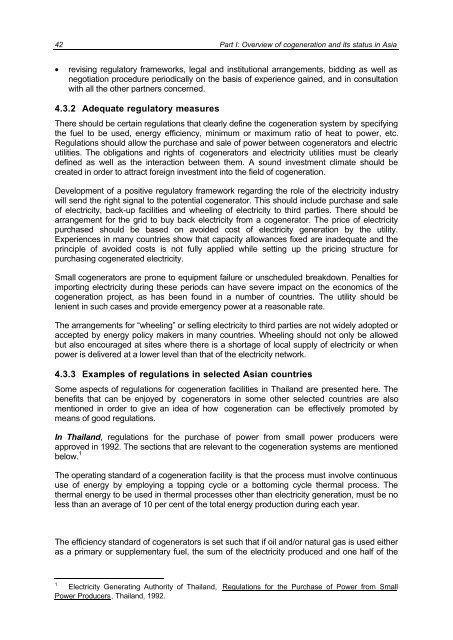part 1: overview of cogeneration and its status in asia - Fire
part 1: overview of cogeneration and its status in asia - Fire
part 1: overview of cogeneration and its status in asia - Fire
You also want an ePaper? Increase the reach of your titles
YUMPU automatically turns print PDFs into web optimized ePapers that Google loves.
42 Part I: Overview <strong>of</strong> <strong>cogeneration</strong> <strong>and</strong> <strong>its</strong> <strong>status</strong> <strong>in</strong> Asia<br />
• revis<strong>in</strong>g regulatory frameworks, legal <strong>and</strong> <strong>in</strong>stitutional arrangements, bidd<strong>in</strong>g as well as<br />
negotiation procedure periodically on the basis <strong>of</strong> experience ga<strong>in</strong>ed, <strong>and</strong> <strong>in</strong> consultation<br />
with all the other <strong>part</strong>ners concerned.<br />
4.3.2 Adequate regulatory measures<br />
There should be certa<strong>in</strong> regulations that clearly def<strong>in</strong>e the <strong>cogeneration</strong> system by specify<strong>in</strong>g<br />
the fuel to be used, energy efficiency, m<strong>in</strong>imum or maximum ratio <strong>of</strong> heat to power, etc.<br />
Regulations should allow the purchase <strong>and</strong> sale <strong>of</strong> power between cogenerators <strong>and</strong> electric<br />
utilities. The obligations <strong>and</strong> rights <strong>of</strong> cogenerators <strong>and</strong> electricity utilities must be clearly<br />
def<strong>in</strong>ed as well as the <strong>in</strong>teraction between them. A sound <strong>in</strong>vestment climate should be<br />
created <strong>in</strong> order to attract foreign <strong>in</strong>vestment <strong>in</strong>to the field <strong>of</strong> <strong>cogeneration</strong>.<br />
Development <strong>of</strong> a positive regulatory framework regard<strong>in</strong>g the role <strong>of</strong> the electricity <strong>in</strong>dustry<br />
will send the right signal to the potential cogenerator. This should <strong>in</strong>clude purchase <strong>and</strong> sale<br />
<strong>of</strong> electricity, back-up facilities <strong>and</strong> wheel<strong>in</strong>g <strong>of</strong> electricity to third <strong>part</strong>ies. There should be<br />
arrangement for the grid to buy back electricity from a cogenerator. The price <strong>of</strong> electricity<br />
purchased should be based on avoided cost <strong>of</strong> electricity generation by the utility.<br />
Experiences <strong>in</strong> many countries show that capacity allowances fixed are <strong>in</strong>adequate <strong>and</strong> the<br />
pr<strong>in</strong>ciple <strong>of</strong> avoided costs is not fully applied while sett<strong>in</strong>g up the pric<strong>in</strong>g structure for<br />
purchas<strong>in</strong>g cogenerated electricity.<br />
Small cogenerators are prone to equipment failure or unscheduled breakdown. Penalties for<br />
import<strong>in</strong>g electricity dur<strong>in</strong>g these periods can have severe impact on the economics <strong>of</strong> the<br />
<strong>cogeneration</strong> project, as has been found <strong>in</strong> a number <strong>of</strong> countries. The utility should be<br />
lenient <strong>in</strong> such cases <strong>and</strong> provide emergency power at a reasonable rate.<br />
The arrangements for “wheel<strong>in</strong>g” or sell<strong>in</strong>g electricity to third <strong>part</strong>ies are not widely adopted or<br />
accepted by energy policy makers <strong>in</strong> many countries. Wheel<strong>in</strong>g should not only be allowed<br />
but also encouraged at sites where there is a shortage <strong>of</strong> local supply <strong>of</strong> electricity or when<br />
power is delivered at a lower level than that <strong>of</strong> the electricity network.<br />
4.3.3 Examples <strong>of</strong> regulations <strong>in</strong> selected Asian countries<br />
Some aspects <strong>of</strong> regulations for <strong>cogeneration</strong> facilities <strong>in</strong> Thail<strong>and</strong> are presented here. The<br />
benef<strong>its</strong> that can be enjoyed by cogenerators <strong>in</strong> some other selected countries are also<br />
mentioned <strong>in</strong> order to give an idea <strong>of</strong> how <strong>cogeneration</strong> can be effectively promoted by<br />
means <strong>of</strong> good regulations.<br />
In Thail<strong>and</strong>, regulations for the purchase <strong>of</strong> power from small power producers were<br />
approved <strong>in</strong> 1992. The sections that are relevant to the <strong>cogeneration</strong> systems are mentioned<br />
below. 1<br />
The operat<strong>in</strong>g st<strong>and</strong>ard <strong>of</strong> a <strong>cogeneration</strong> facility is that the process must <strong>in</strong>volve cont<strong>in</strong>uous<br />
use <strong>of</strong> energy by employ<strong>in</strong>g a topp<strong>in</strong>g cycle or a bottom<strong>in</strong>g cycle thermal process. The<br />
thermal energy to be used <strong>in</strong> thermal processes other than electricity generation, must be no<br />
less than an average <strong>of</strong> 10 per cent <strong>of</strong> the total energy production dur<strong>in</strong>g each year.<br />
The efficiency st<strong>and</strong>ard <strong>of</strong> cogenerators is set such that if oil <strong>and</strong>/or natural gas is used either<br />
as a primary or supplementary fuel, the sum <strong>of</strong> the electricity produced <strong>and</strong> one half <strong>of</strong> the<br />
1<br />
Electricity Generat<strong>in</strong>g Authority <strong>of</strong> Thail<strong>and</strong>, Regulations for the Purchase <strong>of</strong> Power from Small<br />
Power Producers, Thail<strong>and</strong>, 1992.









